Archive for ‘NAPO Conference’ Category
NAPO2014: Organizing Photographs for the Future: Forever and Legacy Box
“Take a picture, it’ll last longer!”
Do you remember that childhood taunt if someone got caught staring? Nobody stares anymore, because everyone is busy taking photographs. The swirl in the coffee foam. Kids playing. Kittens. (Oh, good gracious, lots of kittens!) Breakfast. Lunch. Dinner. Public moments. Private moments. People photograph everything as if to ensure that failure of visual memory need not be as traumatic. (I suspect our great-grandparents had less stress having never heard, “Pics or it didn’t happen!“)
In a recent study published in Psychological Science, a journal of the Association for Psychological Science, Linda Henkel of Fairfield University found that study participants had worse memory for objects (like museum displays), and for specific object details, when they took photos of them. Is it unreasonable to extrapolate that we might better remember baby’s first steps or romantic dinners if we weren’t trying to capture them digitally?
Whatever the case may be, people will likely always be concerned with preserving their memories photographically, so today we’ll be looking at two Organizers’ Choice Award Winners from the 2014 National Association of Professional Organizers Annual Conference and Expo.
FOREVER™
Forever won for Best Productivity Solution for Mobile Workers, but “worker” is probably a misnomer. It’s for mobile humans, people who may be anywhere — any city or state, at home or on campus, in a retirement community or even, eventually, on the moon — but who want their photos with them. But there’s a little (or a lot) more to it than that.
Forever bills itself as permanent cloud storage for your memories. Permanent is an interesting concept these days, because as much as we’ve come to depend on digital solutions, we’ve also realized that we don’t get to control them or their longevity. Sure, we can use various systems, but Google unceremoniously dropped Google Reader last year, leaving millions of RSS feed users bereft. Beloved cloud-based solutions for storing information, contacts or finances (like Springpad, Bump, and Manilla) disappear due to changing business models, buyouts and venture capital failings.
With most cloud-held information, backing up and transitioning to another site may be simple or complicated, but it’s usually successful. Transitioning between two cloud-based photos sites, however, present myriad additional problems, as TUAW editor and Unclutterer blogger David Caolo found recently when he tried to move 14,000+ photos from a prior service to Flickr. During that process, he found that his cloud storage provider had stripped all of the metadata and tags that make photographs searchable.
Stripped metadata is just the beginning. As Forever founder Glen Meakam found, when he prepared to back up his family photos:
…social media sites claimed ownership and compressed everything that people posted. These sites also data mined and sold customer information to make money from advertisers, and when an account was no longer valuable to advertisers, it was shut down. Photo sharing and cloud storage sites were not much better. They lacked sharing capability, necessary media formats, or appropriate organizational tools. All were temporary and avoided granting any permanent ownership or digital rights to customers.
Forever’s model is based on two features: what it does, and how long it will do it.
What it does (the basic services), includes:
- 1 gigabyte of storage (scanned physical items, digitized: 2000 printed photos, 1000 slides, 3 hours of VHS, Hi-8, 8mm film, 4000 pages of documents; digitized content from phones and cameras: 500-2000 photos, one hour of digital video, 140 MP3s)
- triple backed-up, encrypted storage
- guaranteed privacy with no data mining or advertising
- easy photo uploading via the website or mobile app (IOS-only)
- unlimited uploading, downloading and viewing
- non-photo storage, including recipes, legal documents, artwork, clippings (and soon, video)
- full-resolution photo preservation in any size, without compression
- the options to allow compression to make greater use of storage capacity or purchase more storage for a Forever Account
- photo organization in online albums; collation by time, theme, person, etc.
- privacy settings adjustable by image
- complete photo sharing options
- long-term digital migration — as photographic standards change, Forever plans to migrate to new file formats to enable continuous and stable preservation
Additionally, Forever trains and employs print and media organizers to scan, upload and organize photos (for an additional fee). As with traditional scanning/preserving services of this type, Forever sends you a trackable, insured, pre-paid box. You fill and ship it with photos, slides, video or film; they inventory, tag, scan and digitize everything, uploading it all and returning the contents to you.
How long is service/storage guaranteed? Forever claims it’s…well…forever: Your lifetime, plus 100 years! But for anyone whose 10th grade sweetheart promised to love them forever, that word can ring a bit hollow. So, how does Forever promise to future-proof customer’s photos?
Customer fees paid for permanent storage go into a Forever Guarantee Fund, a conservatively-managed fund created to generate income and grow over time, sort of like a university’s endowment. That interest income pays for “permanent storage, uploading, downloading, viewing, and sharing for your lifetime, plus 100 years – guaranteed.” Forever says, “although we can’t guarantee beyond 100 years, our goal is much, much longer. We call it Forever Trust™.”
What does this cost? Permanent membership requires a one-time payment of $250 (or $6.95/month for thirty-six months on the installment plan), and gives you everything listed in the bulleted section above, plus a personalized URL (like PaperDoll.Forever.com) and two hours of phone support. Permanent members can also name an Account Manager for future account administration (in the unfortunate event that you do not last forever).
Introductory membership is free for 90 days, and those members can use the Forever web and mobile apps, including photo sharing and content storage during that period, but have limited storage capacity and no long-term storage promise unless/until they upgrade to permanent membership.
Paper Doll is intrigued by the Forever Guarantee Fund. However, the lack of information on the web site regarding the actual cost of additional storage and the promise of merely two hours of phone support (which, one assumes, means you pay for more assistance over the course of membership) leaves me just about as cautious as one should be of a 10th grade sweetheart’s promises.
APPO™ LEGACY BOX
The Association of Personal Photo Organizers (APPO), founded by Cathi Nelson, is a membership association that trains, supports and provides industry tools to its 500+ members throughout the US, Canada, Australia, and the UK. Member Personal Photo Organizers work to attain the knowledge and expertise necessary to “rescue, manage, organize and save your photos allowing you to easily find, preserve and share your stories.”
APPO has developed a network of industry partners (including Forever™), brands of products and services that APPO’s leadership feels represent the best solutions for organizing photographic memories. At this year’s NAPO Expo, APPO’s Legacy Box earned the Organizers’ Choice Award for Best Solution for Everyday Organizing.
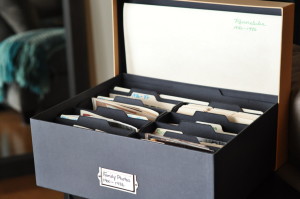
The Legacy Box is an archival storage box line designed to safely store, organize and preserve print photographs in an attractive, acid-free, lignin-free environment.
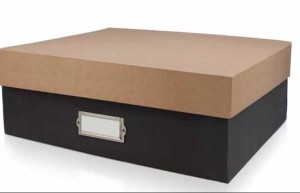 The large Legacy Box (15 3/4″ wide x 13 1/4″ deep x 5 3/4″ high) holds 2400 print photos measuring 4″ x 6″ or 5″ x 7″. It includes 54 dividers for sorting photos into sub-categories, as well as two storage pouches/envelopes (one, 14 3/4″ wide x 5″ high; the other, 7″ wide x 5″ high) for oddly-sized items, like panoramic photos, medals, ribbons and other memorabilia. Also included is an accordion envelope to hold larger photographs and memorabilia. (A smaller Legacy Box holds up to 1200 print photos.) A small, customizable label holder on the front of the box identifies the contents.
The large Legacy Box (15 3/4″ wide x 13 1/4″ deep x 5 3/4″ high) holds 2400 print photos measuring 4″ x 6″ or 5″ x 7″. It includes 54 dividers for sorting photos into sub-categories, as well as two storage pouches/envelopes (one, 14 3/4″ wide x 5″ high; the other, 7″ wide x 5″ high) for oddly-sized items, like panoramic photos, medals, ribbons and other memorabilia. Also included is an accordion envelope to hold larger photographs and memorabilia. (A smaller Legacy Box holds up to 1200 print photos.) A small, customizable label holder on the front of the box identifies the contents.
The Legacy Box is only available for purchase directly through an APPO Personal Photo Organizer.
Print or digital, local drive or cloud, go ahead and take your photos and preserve them for future generations. But please, put the camera/phone down on occasion and notice what’s going on outside the frame. Because, while photos are forever, life zips by in an blink.
NAPO2014: 3 Tools for an Organized House: On the Go, Settled In or For a Move
Organizing your home can be frustrating. You have to remember: “Don’t put things down. Put them away!” That means assigning ideal spots so related items are where you’ll need to access them when you want them. Ease of access and appealing aesthetics are just part of creating a physical system where things belong; you still have to follow a behavioral system of putting them back so they’ll be there the next time.
Today, we’re going to look at a prototype for a new system for keeping your bare essentials accessible and tidy, updates to a favorite furniture line for maintaining order in the home, and a special tool for moving your stuff — to a new home or a new town — and making it practically painless. In each case, form doesn’t merely follow function, but enhances it.
GRAB N’ GO
Pennsylvania-based Finder Enterprises CEO Ray Westphal isn’t the typical tycoon or inventor. But he had a problem and wanted a solution. In his own words:
My frustration with misplacing and searching for everyday personal stuff has led me to come out of retirement and start-up my company, Finder Enterprises, LLC. We have developed our first of two products which are directly aimed at solving these problems. Finder Enterprises, LLC’s GRAB N’ GO™ system is compact and labeled, it lets you know that an item is missing by just one quick glance.
The Grab N’ Go is still a prototype, but that didn’t stop Ray from coming to the 2014 NAPO Conference and Expo to get feedback and share his idea with professional organizers.
This certainly isn’t the first (nor will it be the last) hold-it-all kind of entryway or desktop/dressertop organizer, but there’s something charming in its simplicity. It’s got:
- Six separate sections to keep items from getting tangled or jostled
- Two layers, with the top slightly recessed to keep lower level items visible
- The top left and right sections have cut-outs for charger cables/cords
- An attachable side section for writing implements and sticky notes
What do YOU need to grab quickly to get out the door? Chances are, it’s glasses, keys, phone and money. Wristwatch use may be dwindling (though smart watches may reverse that trend), but wearable tech like my Fitbit is increasingly addictive. (If you wander over hill and dale, only to realize your activity never got measured, were you really ever active?) Having a place for these essentials as you come in or go out is a basic organizing strategy part of the landing strip/launch pad notion.
The Grab ‘N Go prototype comes in two colors right now: white (above) and a smoke/black (below).
Because it’s a new product, and still in development, there’s no pricing, but you can definitely imagine how this simple, sleek product could catch on for everyone from dorm-dwellers to McMansionites.
CLOSETMAID® CUBEICALS AND PREMIUM CUBES
While Ray’s was a new face at the NAPO expo this year, we also had a veteran home design vendor in the house — our friends from ClosetMaid! We always delight in seeing ClosetMaid’s new products, which this year included some stunning upgrades to their Impressions™ and Selectives™ do-it-yourself laminate systems and the reach-in closet system, ShelfTrack® Elite. The ShelfTrack line is especially appealing for use with kids and teens, as its adjustable mounting system helps create a flexible combination of hanging and shelving/drawer space to grow as kids grow.
But let’s face it, ClosetMaid is particularly beloved by organizers and the disorganized alike because of one stellar product: Cubeicals®! It’s a rare person who hasn’t seen (or, I’d hazard, bought) a set of cubed shelves with those collapsible, colorful fabric drawers. I’m sure you’re used to the standard Cubeicals collection available at Target, Staples and Lowe’s, which comes in laminate 6- and 9-cube organizers and 3-cube bench styles.
 For example, this three-foot high, nine-cube, white laminate organizer is perfect for a variety of bedroom/family room/entryway storage purposes and suitable for holding toys, clothing, books, handbags, or just about anything. They’re easy to put together and can be customized with doors and colorful fabric bin drawers in a variety of colors:
For example, this three-foot high, nine-cube, white laminate organizer is perfect for a variety of bedroom/family room/entryway storage purposes and suitable for holding toys, clothing, books, handbags, or just about anything. They’re easy to put together and can be customized with doors and colorful fabric bin drawers in a variety of colors:
Variety is the name of the game with these bin drawers. The Classic color line includes Green, Fiesta (orange), Red, Cabernet (brownish-red), Oasis (dark green), and two shades of blue, a light and dark denim. I’m not sure whether the Trendy line changes with the seasons, but Kiwi Green, Ocean Blue, Spring Green, Fuchsia, True Blue and Purple are their current selections. The Neutral line, probably more suitable for a man cave or formal living area, sports Natural (tan), Grey, Mocha, Charcoal Grey, Canteen and Black. The Playful line is perfect for a nursery, with cheery Yellow, Pale Blue, Pink, Hunter Green, Light Purple and Royal Blue options. These non-woven polypropylene cubes (which feel like soft canvas) measure 10 1/2″ wide and deep, and 11″ high, and have one cloth, looped handle. They’re generally priced around $7.75.
For those who like a two-handed option, ClosetMaid has some Target-exclusive bin drawers in some classy colors (solids in French Vanilla, Cascade Blue, Graystone, Taupe, Evergreen, Red and Coffee Bean, as well as patterned in French Vanilla/White and Graystone/White), with the traditional handle and a smaller looped pull-tab (for those who wish to turn the smaller tab side facing outward). They’re priced at $10. A separate Premium Fabric Bin line (unrelated to the Premium furniture line below) includes two brown faux leather handles on opposing outer walls of the Robin’s Egg, Rustic Bronze, Clay Brick and Warm Cocoa 10 1/2″ cube options. They’re priced at $11.50.
The big news at the Expo was ClosetMaid’s new Premium Cube Organizers, available only at Home Depot. They were even the winner of the NAPO 2014 Organizers’ Choice Awards for Best Solution for Organizing Storage Space.
Available in 6-cube and 9-cube styles, the Premium cubes, designed for a more formal living space, feature a rich mahogany finish, a full back-panel, hidden hardware and decorative molding. The coordinating Premium bin drawers come in two styles: 13″ cube two-handle bins (available only from ClosetMaid.com) and 10 1/2″ wide by 10 1/2″ deep by 11″ high one-handle bins, exclusively at Home Depot. As you can see above, contrasted with the standard ClosetMaid bins, these are sturdier, non-collapsible bins with reinforced cut-out handles and linen, polyester and faux leather finishes. Home Depot is pricing the 39″ high x 26″ wide 6-cube unit at about $70, and the 39″ high x 37″ wide 9-cube unit at $80.
ClosetMaid has still another new line of 6-cube and 9-cube vertically-adjustable units, available only at Target.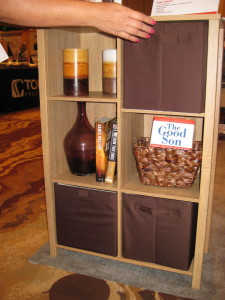
These also have full back-panels and hidden hardware, and come in premium wood grain laminate with textured embossing. The Premium 6-cube version, above, comes in Weathered Teak and Black Walnut finishes and measures 38.31″ high x 25.81″ wide x 11.81″ deep; the Premium 9-cube unit is available in Weathered Oak, Dark Chestnut and Black Walnut finishes and measures 38.31″ high x 37.6″ wide x 11.81″ deep. The vertically-adjustable shelving allows you to accommodate big binders, oversized books and tall knickknacks, but still gives you the option of using the traditional cubes. The 6-cube and 9-cube versions retail at Target for about $45 and $60, respectively.
So, Finder Enterprises covers organizing your small things, and ClosetMaid has a handle (and sometimes two!) on organizing the big stuff…where, hopefully, it will stay put!
MOVE-N-ORDER
When your life is in flux due to a move, overwhelm about where your stuff is at any given moment is at an all-time high. Whether you’re working with experienced, high-quality moving professionals or trying to get from your dorm back to your parents’ house with a U-Haul and a prayer, moving is stressful. Finding what you need when you arrive (or even en route) shouldn’t add to that stress.
Virginia-based Professional Organizer Maria White of Enuff With the Stuff has developed Move-N-Order, a kit for a color-coded moving system so that you can ensure that each piece of furniture and every box gets to the right location in your new space.
Move-N-Order comes in two versions, one for four-bedroom home moves and one more suitable for moving from a two-bedroom condo or apartment. The kits include:
- Graphed floor plans with an inventory tracker for boxes and furniture to make sure that everything is accounted for — the four-bedroom home kit includes 11 floor plans; the two-bedroom condo has 7 floor plans
- Brightly colored, numbered, removable furniture stickers (154 for the four-bedroom, 98 for the smaller move)
- Extra-large, brightly-colored box stickers, designed to fold over box edges and be visible from the top and side (292 stickers for the four-bedroom, 124 for the smaller move)
- “Open First” stickers so that when you arrive late, hungry, sweaty and tired, a few dishes and glasses, a shower curtain and your toiletries will be close at hand
- “Fragile” stickers, because there’s always a chance someone might treat a box marked “fragile” with extra sensitivity
- A series of expert Quick Packing tips and Day-of-Move tips from Professional Organizer Maria White
- A downloadable, professional 40-minute staging tips video
- A downloadable book, entitled Improve Your Move, How to Prepare Your Home for a Move.
The Improve Your Move book covers topics including starting to prepare for a move, how to design a room plan for your new home, how to prepare your own home for sale (including routines to follow to keep your home show-ready), packing steps for self-movers, special tips for moving with children, and guidance for what to keep with you in your car during the moving process.
The four-bedroom home kit sells for $85, while the two-bedroom condo kit is $75. Both can be purchased directly from Move-N-Order.
If you’re planning your next move, or you’re a professional organizer who works with client relocations, you should know that Maria is offering Paper Doll readers a discount on purchases of either version of Move-N-Order. Just use the discount code:
paperdoll
when you check out and you will receive a 10% discount on your Move-N-Order purchase.
Whether you’re staying put, heading out the door, or moving across town or across the world, may you have an organized day!
NAPO2014: Wirelessly Scanning the Horizon — What’s New in Scanning?
Whether your goal is to go paperless or you just want to make sure you have access to your information no matter where you are, scanning is an obvious solution. We’ve previously covered the basics of scanning as part of a paper-reduction policy, and there’s a whole section on scanning in my 57 Secrets for Organizing Your Small Business.
At the 2014 NAPO Conference and Expo, two long-time stars of the scanning world, Neat and Fujitsu, displayed their newest wares.
FUJITSU
Fujitsu ScanSnap iX500 Desktop Scanner
The ScanSnap iX500 is a desktop scanner (but, as the photo above indicates, not a flatbed scanner) compatible with Macs and PCs as well as mobile devices. (It replaces the Scansnap X1500, a Windows-only scanner.) Suitable for personal or small business use, the big selling point of this model is the ability to scan wirelessly, but the iX500 has myriad interesting features, including:
- scanning to a wide variety of formats, including searchable PDFs, JPEGs, editable Microsoft Word and Excel documents, and others with the press of just one button
- scanning to the cloud, including to Dropbox, Google Drive, Salesforce, and SugarSync, as well as SharePoint, but only for Windows-based PCs. (ScanSnap Folder, also compatible only with Windows-based PCs, allows for wider cloud-centric applications.)
- Wi-Fi connectivity — sure, you can connect your scanner to your computer via a USB cable, but you can also scan directly from the iX500 to your computer via your Wi-Fi connection, cable-free!
- direct scanning to mobile devices — scan a PDF or JPEG from the iX500 to your iOS or Android mobile phone or tablet directly via WiFi
- fast double-sided scanning of color pages at 25 pages/minute at 300 dpi. The iX500 scans both side of a page simultaneously, and images are automatically straightened and cropped, with blank sides removed from the resulting scan. (Although the stated speed is 25 pages/minute, reviews have reported speeds as high as 33 pages/minute. Check out this tweeted Vine of a sheet zooming through the iX500!)
The ScanSnap Quick Menu gives you an idea of the variety of destination options at your disposal:
You can stack up to 50 sheets of paper at a time in the automatic document feeder, and Fujitsu promises that by borrowing “Separation Roller” technology and an “ultrasonic multi-feed sensor” from their professional-grade scanners, they’ve minimized jams and that annoying situation where more than one page gets grabbed at a time (and then never gets scanned at all).
The ScanSnap iX500 comes with productivity software. For both Macs and PCs, there’s Cardminder, a business card program. For PCs, there’s ScanSnap Organizer, which lets users manage PDFs and JPEGs scanned on a Windows platform, including converting scanned PDF files into searchable content. The ABBYY FineReader Express Edition is the similar PDF-to-searchable-PDF conversion software for the Mac.
Review posts have generally been positive, as have social mentions:
Ok. Really liking my new scansnap ix500. That feeder doesn’t miss a beat. After many battles with my crap HP “all in one” this is bliss.
— NomdeB (@NomdeB) July 9, 2014
ScanSnap iX500 won this year’s NAPO Organizers’ Choice Award for Best Solution for Organizing Information at Work.
The iX500 ranges from about $430 to $485 via Amazon, office supply stores like Staples and Office Depot, and other big box and online electronics stores.
NEAT
NeatConnect is the newest addition to the NeatDesk and NeatReceipts family. 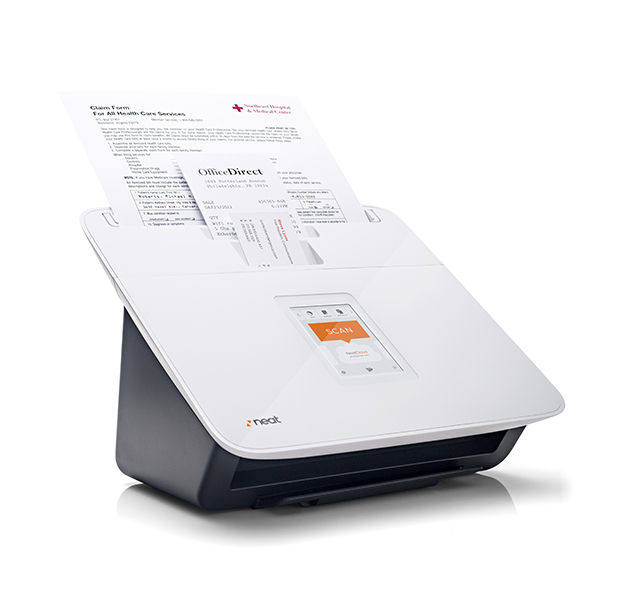 NeatConnect has taken the concepts of “less is more” to new heights, focusing on how this scanner not only helps you be paperless, but also wireless and computer-less. You can:
NeatConnect has taken the concepts of “less is more” to new heights, focusing on how this scanner not only helps you be paperless, but also wireless and computer-less. You can:
- Wirelessly scan documents directly to the cloud, including to Dropbox, Evernote, OneDrive, Box, Google Drive, email and even FTP. However, in this instance, the “cloud” isn’t necessarily the random cloud solutions you already use, but also NeatCloud, a subscription-based storage service accessible from your NeatConnect, computer or Neat mobile app. (You get three months of free NeatCloud service with your NeatConnect purchase.)
- Skip the computer altogether. As long as your Wi-Fi can reach it, the NeatConnect doesn’t need to interface with a computer. Just pop in the items to be scanned (in any or all of three size formats), use the intuitive touchscreen to swipe through the destination options, and tap “Scan” when you’re ready.
- Wi-Fi down? NeatConnect isn’t so wedded to the wireless option that you’re stuck. There’s a USB port for connecting to a Windows PC or Mac.
- Scan to email, even without the computer. Once you scan an item, you can send it via email as an attachment.
- Gain a cordless storage option via one SD card slot for saving scanned images up to a maximum of 32 GB.
- Opt for one-sided or duplex scanning, and then save pages separately or combine them.
The stated upper-limit scanning speed of the NeatConnect is 24 pages per minute for color, black-and-white or grayscale, 300 dpi, slightly less than iX500’s stated speed, though I’ve seen reports that real-time NeatConnect usage yields a somewhat lower speed. (Both Neat and Fujitsu have a maximum scanning resolution of 600 dpi.) While the iX500 allows you to stack all of your documents to process through one feeder, the NeatConnect has three separate feeding slots, with a maximum capacity of 15 business cards, 15 receipts or small scraps, and 15 letter-size documents. (Without the paper tray, the capacity is the same 50 sheets as the iX500.)
If you’re interested in the NeatCloud, be prepared to pony up $6, $15 or $25 per month, depending on whether you want a personal, home and office, or business plan. (Annual plans at $60, $120 and $240 lower the per month price considerably.)
In the past, the main complaint I’ve heard about the Neat scanning platform was that its software was pretty insular — that you had to scan to what amounted to a Neat “inbox” and only later could you move items onward; NeatConnect seems to circumvent that complaint with more widespread integration options. And it certainly has its fans.
Closest to perfect scanner I’ve ever seen is the NeatConnect Cloud Scanner. Why? It bypasses any computer, scans straight to cloud. — Steve Sande (@stevensande) December 31, 2013
The Neat mobile app is available for iOS and Android devices, and supports functions including image capturing, editing, sorting, searching, sharing, expense reporting and reading of U.S. and Canadian receipts and business cards. The optional Neat Verify service (for an additional monthly fee) sends your mobile-scanned image to a team of Neat specialists who review the scan and ensure that the “key information is accurately read and extracted.” You could think of this as a really inexpensive virtual assistant who double-checks your numbers or a creepy NSA dude who helpfully lets you know your scan misread a restaurant tip.
NeatConnect runs about $499.95 and is sold directly through Neat, and is available at Amazon and various office supply and electronics stores.
PAPER DOLL’S THOUGHTS
This post should not be construed as a review, but merely a recap, of what I learned at this year’s Expo, plus some research. Although I may be an expert on organizing paper and digital files, my scanning experience is limited. Rather, I direct you to some recent reviews of the ScanSnap iX500 and NeatConnect that seemed particularly helpful at pointing out the merits and shortcomings of both.
- MacSparky: The Fujitsu ScanSnap iX500
- DocumentSnap: Fujitsu ScanSnap iX500 Review
- TechDad Review: iX500 Document Scanner
- Lawyerist: NeatConnect Cloud Scanner Review
- Cult of Mac: NeatConnect Is the Wireless Scanner You’ve Been Waiting For
- TUAW: NeatConnect Cloud Scanner: Computerless Scanning and Digital Filing
My gut instinct is that Windows users, businesses and speed-scanners will love the iX500; for novices at scanning, home/personal users, those who care about their hardware aesthetics, and heavier users of a wider array of cloud options, I suspect the NeatConnect will hold more sway. As a thirty-year Mac user, my cursory experience is that NeatConnect is slightly more intuitive, but I’ve read the opposite claim in multiple reviews. Your mileage may vary.
My suggestion? Poll your local buddies and visit the homes and offices of those who are using both to get a real-world tutorial. I know the ScanSnap vs. Neat fans are as loyal (read: partisan) as Mac vs. Windows or Yankees vs. Red Sox folks, so please feel free to weigh in with what you love (or don’t) about either option.
NAPO2014: Fashion-Forward Organizing Solutions
Although Paper Doll generally focuses on managing your paper to be more organized and productive, sometimes we need to flip the picture, and look at ways to be more organized and productive to save (little green pieces of) paper. To that end, this post will review two wardrobe-oriented products from this year’s National Association of Professional Organizers Conference and Expo: one for helping you eliminate closet clutter, and one to change how you think about putting away your clothes. Both will help you save time and money, and maybe make you feel a little more fashionable.
MY WARDROBE GENIE
My Wardrobe Genie is the brainchild of Massachusetts-based Professional Organizer Susan Terkanian of AllSET Solutions. Susan explains My Wardrobe Genie as a personal clothing management assistant, a way to deal with the overwhelm of items in your closet with ease and confidence, but without undue expense. She has not only tested her system with real clients, she got input from a neuropsychologist!
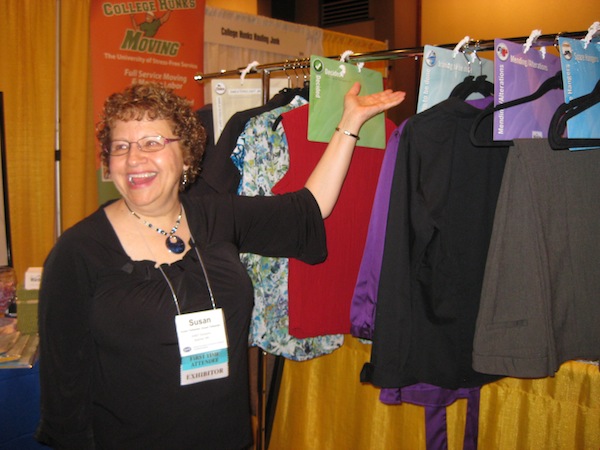 The key to a working wardrobe is keeping clothes that fit (your body and your lifestyle) as well as flatter, but letting go of what misses the mark: even if it was pricey, even if you’ve got happy memories associated with it, even if it was a gift. Intellectually, you know that you’ll never wear that itchy, ugly sweater that you’ve been guilted into keeping all these years. And putting those slacks with the ripped hem back in the closet (because you forget about the hem, every time, until you put them on) is like putting an empty milk carton back into the fridge.
The key to a working wardrobe is keeping clothes that fit (your body and your lifestyle) as well as flatter, but letting go of what misses the mark: even if it was pricey, even if you’ve got happy memories associated with it, even if it was a gift. Intellectually, you know that you’ll never wear that itchy, ugly sweater that you’ve been guilted into keeping all these years. And putting those slacks with the ripped hem back in the closet (because you forget about the hem, every time, until you put them on) is like putting an empty milk carton back into the fridge.
To reduce clothing clutter and get a handle on what you own, My Wardrobe Genie combines the two essentials of any working system: a physical set-up and a behavioral process.
For the closet, My Wardrobe Genie comes with five colorful, laminated divider placards that hang from your closet’s rods to divide your closet into zones. These placards designate:
- Discerning/Decided — This nifty placard divides your closet rod into two areas: what you know for sure that you’re keeping, and what you’re still noodling over in your head. Just that one initial sort as you return clean clothes to the closet, or work your way down the rod, sets the stage for making decisions. Does this fit me? Do I wear it? Does it look (and feel) good? If you know, it goes on the Decided side of the placard. If you are still working on discerning the value, or trying to figure out if it will be donated, discarded, or otherwise distributed elsewhere on the planet, it goes on the Discerning side. Everything in your wardrobe starts out on the “Discerning” side, but (as indicated), once you decide, you move it to the other side of the divider.
- Anything Pressing? — Aside from the hardy few who get their moments of Zen from ironing, not many people are a fan of getting out the ironing board and pressing their clothes. But if your to-be-ironed clothes are out of sight and piled in the laundry room, you’ll never be inspired to tackle the ironing, and if they’re mixed in with the other clean, ready-to-wear items, you’ll pass over them when you make haste to dress. Keeping all the to-be-ironed clothes together lets you know when it’s time to turn up the music and rock out (or zone out) while ironing.
- Mending and Alterations — Sure, it’s great for you to pull out the mending and put it by your sewing machine (or the bag to take to the tailor), but the truth is, at best, you’ll just be creating more piles that you probably won’t get around to addressing. With this section divider, you can see at a glance when you have enough items to make it worth zipping over to the tailor or blocking off time in your schedule to do mending. (For those wondering, for any “mending” more complicated than re-attaching a button, Paper Doll believes in the power of delegation! Why deny someone employment using skills that far surpass my own? Paper Mommy has taught me well.)
- Spare Hangers — Because putting an empty hanger back where you pulled it from is a guarantee that your closet will become disheveled quickly! Store all your spare hangers together to find the right kind when and where you need them.
- Customizable — There’s a blank placard for you to customize to your preference. Maybe you have work uniforms that you want to keep separate from your casual and dressy clothes. Or, perhaps you’re keeping maternity clothes handy for a planned-for blessed event. Make that closet zone work for you.
For those of us who categorize our clothes by color, weight, sleeve (or skirt) length, or other attributes, there’s no need to revise. You can still be that granular in organizing your closet — once you get things to the Decided zone.
Each My Wardrobe Genie kit comes with the five placards, five colorful, coiled elastic hanger cords (to attach the placards to the closet rod), a discard bag, a donation bag, and labels for the bags. Susan expects the My Wardrobe Genie online store to be in place this July.
Although pricing is not listed on the site, the original IndieGoGo campaign looked to price each kit at around $30.
In theory, could you do this on your own? Sure, but as with most organizing concepts, we find that if people could do them on their own, they would have already done so. My Wardrobe Genie gives you that extra guidance to move forward, physically and behaviorally. My only thought is that people with truly overstuffed closets (and/or bad lighting in their closets) may still need a little extra hand-holding from a friend or professional organizer to tackle the initial phases of whipping the closet into shape.
While My Wardrobe Genie is great for your closet, what do you do if you’ve got a lot of drawer-based clothing? For those who lack expansive (and sometimes expensive) walk-in closets, a small closet space means relegating anything that doesn’t have to be hung up to whatever drawer space exists. But if you’ve lots of clothing but not a lot of drawers, what’s a fashionista to do?
PLIIO®
Luckily, there’s Pliio®. Longtime readers of this blog know how much I appreciate this innovation that lets you, for all intents and purposes, file your clothing, upright! But in case you’re new to what Pliio has to offer, I’ve got a little recap. Co-created by Canadian Professional Organizer Clare Kumar of Streamlife, Pliio is one of those brilliant tools that makes you wonder how and why it took so long for someone to come up with it.
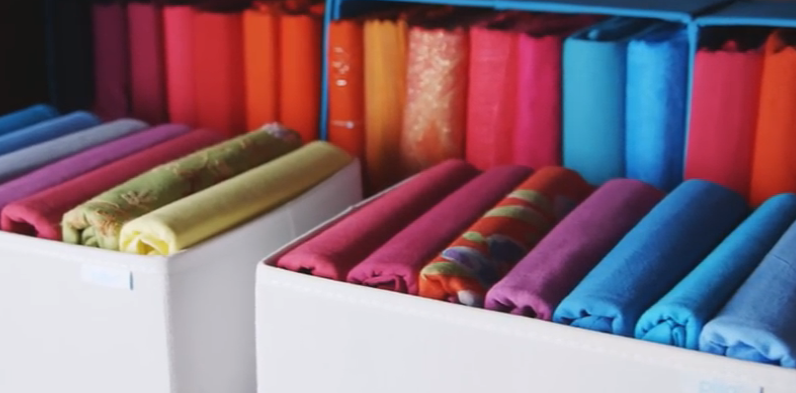 Pliio, itself, comes in two parts: the Pliio® Clothing Filers™ (17″ long x 8″ wide x 1/4″ thick),
Pliio, itself, comes in two parts: the Pliio® Clothing Filers™ (17″ long x 8″ wide x 1/4″ thick),  which are essential to the process, and the Pliio® Organizing Boxes (9″ x 11″x 5″), which serve as the wardrobe equivalent of a desktop file box, filing cabinet or drawer.
which are essential to the process, and the Pliio® Organizing Boxes (9″ x 11″x 5″), which serve as the wardrobe equivalent of a desktop file box, filing cabinet or drawer. 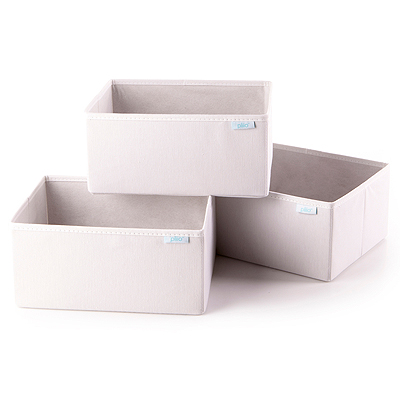 The basics are pretty simple — practically any article of clothing can be wrapped and folded around the Pliio clothing filers. I’ve seen Clare work magic with T-shirts, jerseys, light-weight knits and sweaters, as well as soft (sort of flowy) unstructured bottoms, like yoga pants or skirts, and even dresses. The thinner the fabric, the better it works, and the instructions say that it all works best when there’s about three inches of excess material beyond the edge of the filers.
The basics are pretty simple — practically any article of clothing can be wrapped and folded around the Pliio clothing filers. I’ve seen Clare work magic with T-shirts, jerseys, light-weight knits and sweaters, as well as soft (sort of flowy) unstructured bottoms, like yoga pants or skirts, and even dresses. The thinner the fabric, the better it works, and the instructions say that it all works best when there’s about three inches of excess material beyond the edge of the filers.
See it in action:
Once your clothing properly Pliioed (what? it’s not a verb yet?), you can easily lined up clothing wherever you want it to go — in your drawers, on your closet shelves, or even in your luggage! Use the organizing boxes to keep them perfectly aligned for added orderliness. You only need six inches of depth in your drawers or suitcases to accommodate Pliio Clothing Filers, and you can turn the boxes on their sides (for six inches of depth and nine inches of height) to stack filed clothes anywhere, even on CD/DVD shelves!
For a while after Pliio’s release, you could only buy it on QVC, but it’s available (in the U.S. and Canada) at Bed, Bath and Beyond for about $20/set of ten filers.
It’s not easy to impress me with “doodads,” and I’m fairly frugal, so I only buy what I find to be flawless, but I’ve given Pliio as gifts. One friend with refined tastes — who is already incredibly organized (and isn’t even a professional organizer!) — liked the system so much, she went out and bought more, and Pliioed her husband’s T-shirt wardrobe!
My Wardrobe Genie and Pliio are just two inventive ways to get control of your clothing, get organized, and stop wasting time and money on closet clutter.
NAPO2014: It’s a Wrap! Organizing Your Wrapping Supplies with Wrap It!
It’s not yet July, but some people are already thinking about the holidays! This tweet, from a fun-loving scientist I know, illustrates eagerness to get started on shopping and wrapping:
pretty sure I’m the only person who during this break before work dinner wrapped Christmas presents.
— Kelly O. Sullivan (@KellyOSullivan) June 18, 2014
And though it turned out to be a mistake, a post office branch in the Williamsburg neighborhood of Brooklyn, New York actually started promoting Christmas stamps this week!
While it’s not a paper and productivity topic we touch upon often, eliminating gift wrap clutter and organizing your wrapping options is definitely something we’ve discussed previously:
- It’s a Wrap! Wrapping Paper Alternatives, Furoshiki & Frogs
- Paper Doll Wraps Up the Holidays and Makes It All Stick (Part 1)
- Paper Doll Wraps Up Some Alternatives to Wrapping Paper (Part 2)
THE PROBLEM
Birthdays and holidays and baby showers. Oh, my!
Anyone who has ever tried to wrap a series of gifts of varying shapes and sizes knows that wrapping is not a one-size-fits-all experience. In the pre-gift bag era, I once tried to wrap an unboxed, stuffed lion for my best friend’s toddler, and there is photographic evidence (which I will not share), indicating that I failed wrapping school. A roll of shiny tape and perhaps two pounds of tissue paper later, it looked like a lump — maybe a soccer ball, maybe a chemistry set. Trust me, it looked better once unwrapped.
The options are almost endless. Wrapping paper comes in different lengths, and the volume on each roll varies. Sometimes wrapping paper comes flat, folded in squares, so that it takes up less space (but has an annoying crease, usually just where you wish it didn’t). And tissue paper is packaged altogether differently, folded like pre-GPS gas station maps. Sometimes, a gift bag is more apt, but bags come in multiple heights and widths, and then there are the ribbons and bows and furry/fuzzy/sparkly/twinkly stuff sold to adorn the gifts you give. (This is where Paper Mommy excels. All presents for children, and some for adults, are decorated with lollipops and similar candies. Twice the fun, none of the glitter.)
With so many different kinds of wrapping supplies, you end up needing different kinds of containers. Sometimes, an under-the-bed, flat-ish lidded bin will work, but it can be hard to find one to accommodate the longer rolls of wrapping paper. There are a variety of standing solutions that emulate trash cans, but unlike Weebles, when they wobble, they do fall down. I’ve seen many of my more artsy/craftsy clients peruse Pinterest for DIY-solutions to sew or glue or create themselves, but that can take a lot of labor.
Then there are the supplies. Tape — you want the non-shiny kind so that it’s invisible against the wrapping paper. Scissors. Those little noodle-y things that help you make ribbons curl nicely! Do you store them with your wrapping station (if you have a wrapping station more robust than “in the closet” or “under the bed”) or do you borrow from the office supply/school supply/miscellaneous drawers of your house? And if you can’t find what you need and end up buying duplicates, you’re worse off than if you hadn’t had any supplies in the first place!
It’s enough to make you want to give everyone a gift card and call it a day!
At this year’s NAPO Expo, however, a new product came to market for keeping all of your gift packaging supplies under wraps.
THE SOLUTION
WRAP iT™, developed by New Yorker Adam Levine (pictured below), is designed to create a
solution for neatly organizing and storing all gift wrap supplies. I have to admit, I was dubious. I’d seen what amounted to zip-up garment bags for wrapping supplies before, and in the end, everything tended to fall to the center of the bag, like hockey sticks in a duffel. (Am I betraying my Buffalo, NY roots?)
But Wrap iT really is different.
Wrap iT comes in two color schemes (blue and copper) and two sizes: Deluxe and Original. The interior of both versions can hold 26 rolls of wrapping paper, up to half of which can be the extended-length rolls (in the Deluxe version (pictured below)), which are often too long to fit in any standard paper organizer. The wrapping paper is held in place with heavy-duty elastics. When you’re done wrapping, slide the roll into the elastic bands at the top and bottom, twirl your roll about one-half a turn, and the loose ends remain tucked in place. No straggling ends to rip or tear.
In addition to the interior section, the Wrap iT has multiple clear PVC pockets to accommodate folded wrapping and tissue paper, gift bags in multiple sizes, gift tags and greeting cards, bows, ribbons and wrapping tools, as shown below.
Adam and his people refer to the Wrap iT as similar to an “Armored Gift Wrap Tank” made extra-sturdy to protect those delicate bows and frilly ribbons. In addition to the high-grade elastics, the clear PVC is water-repellent (in case you’re schlepping through snow to get to a gift-wrapping party) and has a heavy-duty, all-the-way-around nylon zipper. Velcro closures clasp the nylon flaps to the PVC pockets.
The Deluxe Wrap iT measures 44″ long by 19 1/2″ wide, and fully stuffed is 4″ thick. Empty, it weighs only 1.8 pounds, but has a maximum storage capacity of 22 pounds. (That’s a lot of wrapping!) The Original Wrap iT is the same width and thickness when packed, but a touch shorter at 33 1/2″ long. It’s 1.6 pounds empty and 19 pounds at full capacity.
Thus, storage is easy, as the bag lays flat enough to slide under a bed, but the build-in hanger lets you easily hang it vertically in whatever closet has four inches of adequate width and enough depth to handle a winter coat.
The Deluxe sells for $59.97; the Original for $54.97; you can also get a combo pack of one of each or a two-pack of either size for $99.94.
See the Wrap iT in action:
Paper Doll has to be honest. I’ve long since given up on wrapping presents. If it fits in a gift bag, I’ll surround it with some pretty tissue paper; otherwise, I’ll probably have it shipped directly from Amazon and that charming A to Z logo will serve as all the wrapping it will have. But if I were a wrapper, especially one with lots of tiny tot birthday and holiday gifts to decoratively wardrobe, the Wrap iT would be hanging in my closet.





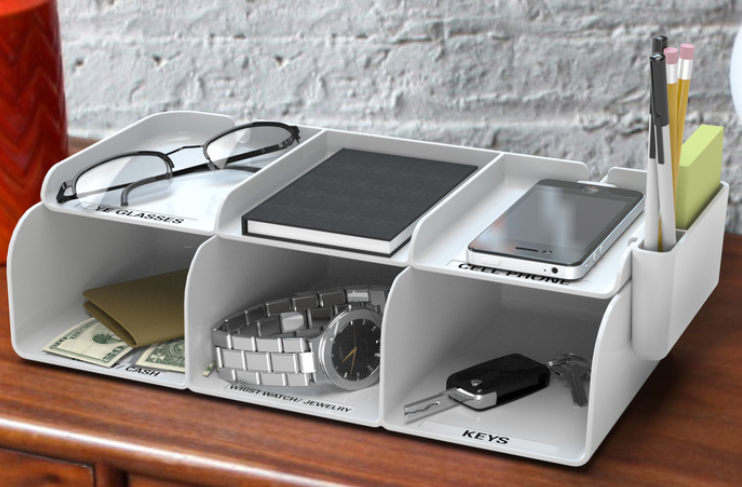
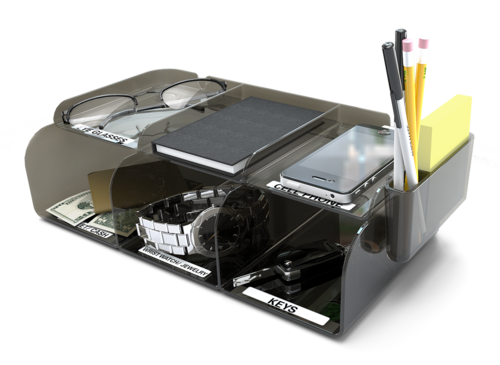
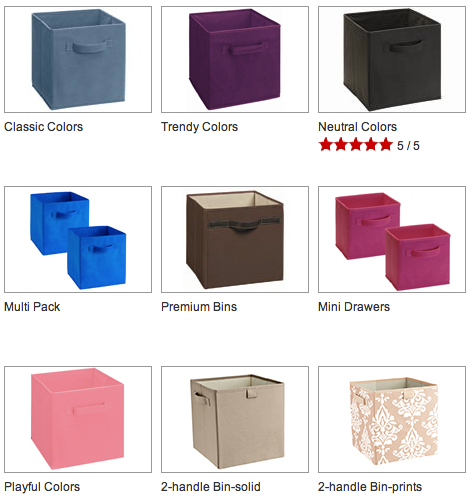
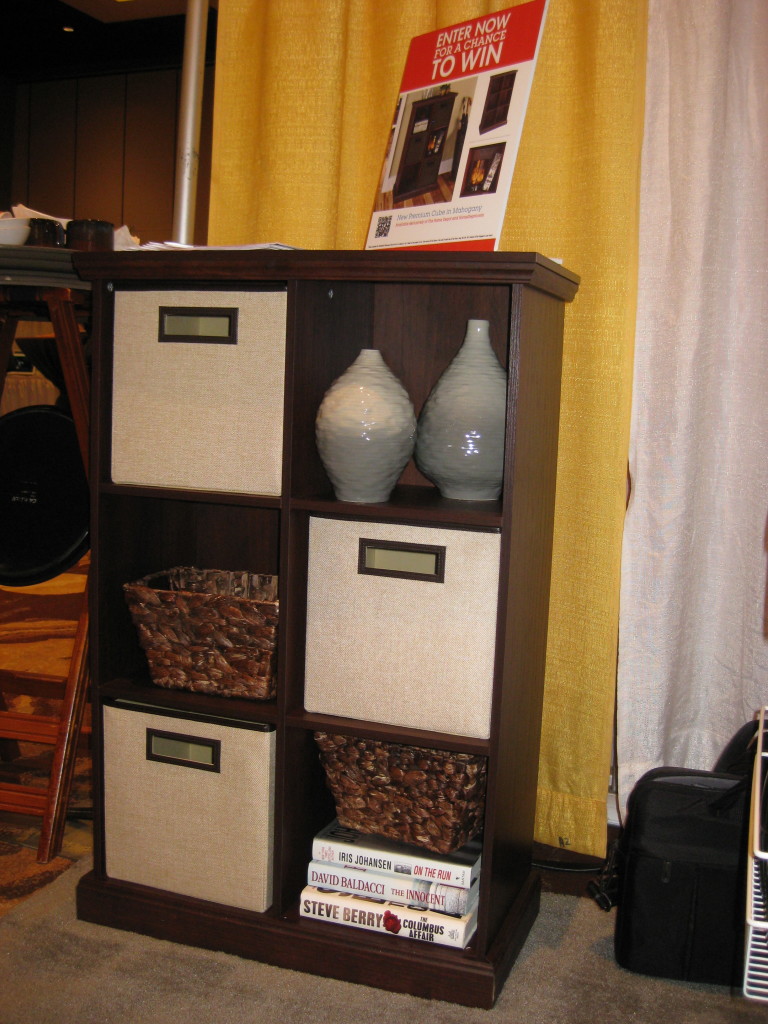
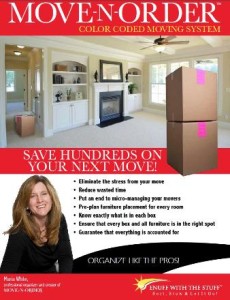

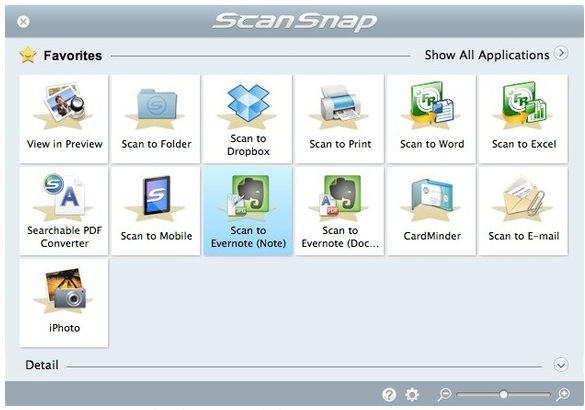

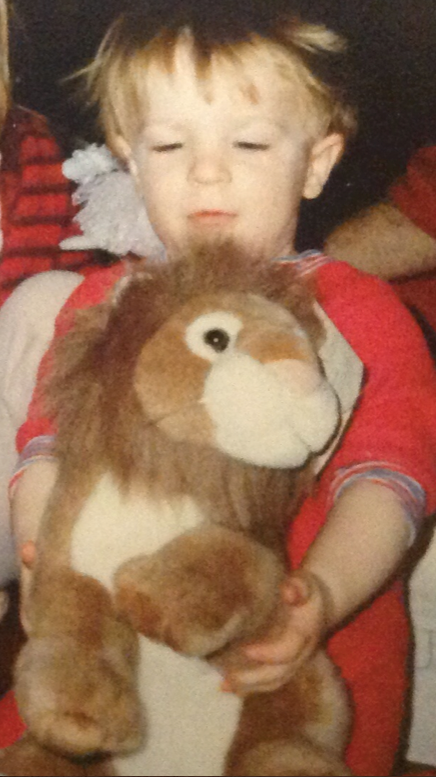
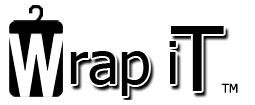
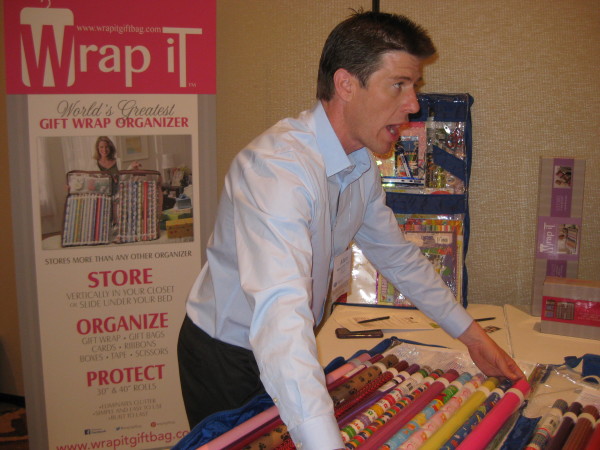
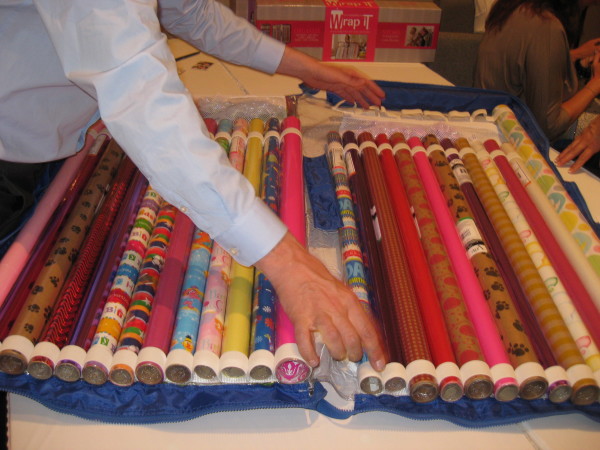
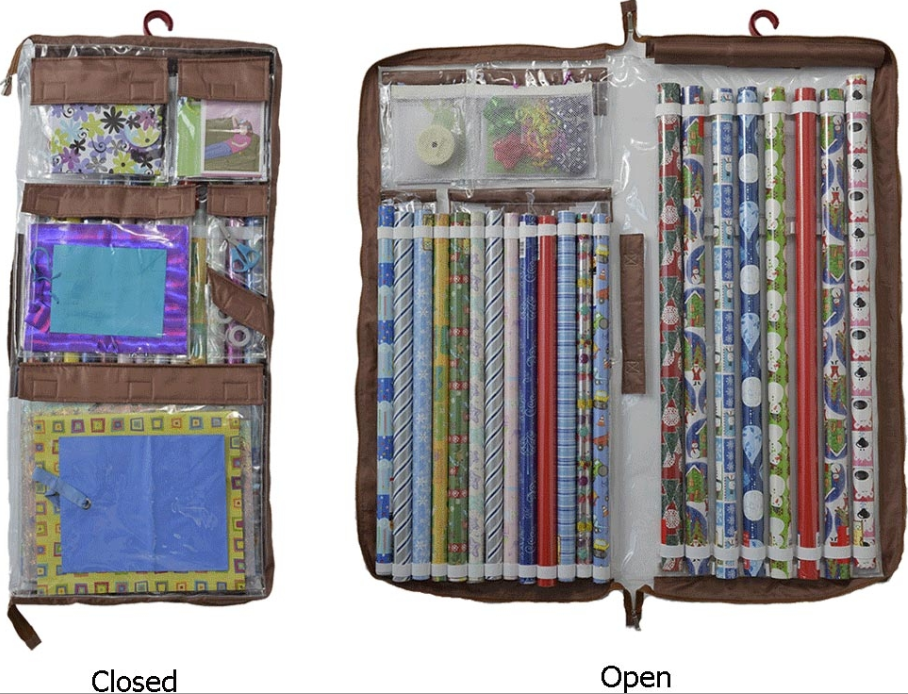
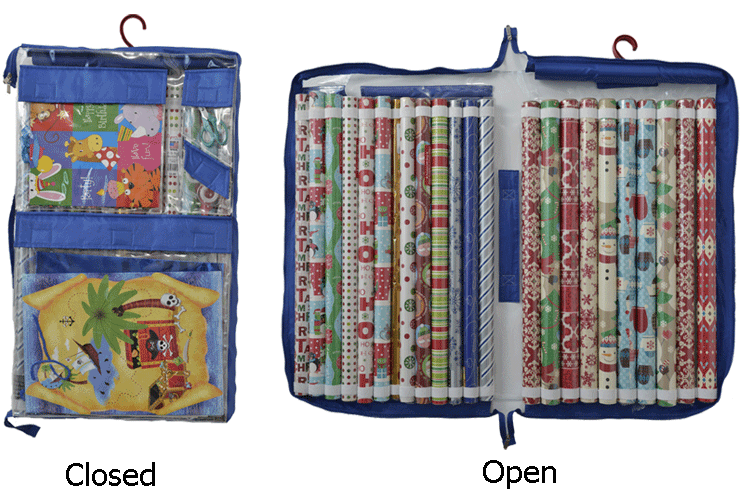




Follow Me